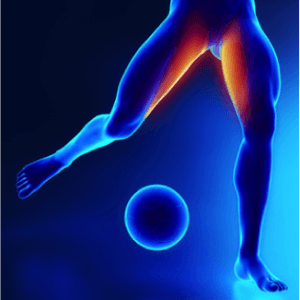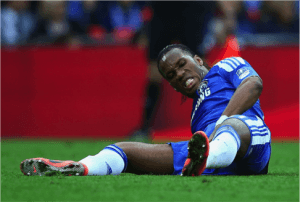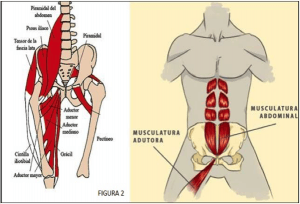Groin and Hip pain is an extremely common presentation in sports and exercise medicine, particularly in footballers, yet it is poorly understood. The anatomy of the region is complex; the load on this region is extremely high in sports that involve rapid change of direction and kicking, and the hip joint itself is not a superficial joint and therefore is hard to examine.

In 2008, there was a meeting amongst world leaders in groin pain with the aim to create a standard terminology to be used when describing different groin and hip pathologies. This is known as the Doha agreement. From this meeting three subheadings were created to encompass the causes for groin pain:
- Defined clinical entities (adductor/inner thigh-related, iliopsoas/front of thigh/hip flexor-related, inguinal-related and pubic related)
- Hip-related groin pain
- Other causes for groin pain in athletes
Risk factors for acute or chronic groin and hip problems are particularly prevalent in footballers. It is known that having a previous groin injury almost doubles your chance of developing new groin injury.
USEFUL LINKS
Main Groin and Hip risk Factors:
- Previous injury
- Greater hip abductor to adductor strength ratios
- Core muscle weakness and
- Decreased pre-season sport specific training.
Over seven consecutive European football seasons groin injuries accounted for 1.1/1000 hours training sessions and/or games missed. Match injuries where significantly higher compared with training injuries. It was calculated that 27% of groin injuries were traumatic in nature, and 73% were caused from overuse. 7.2 groin injuries were calculated per club, per season (Brukner & Kahn, 2014).

Groin and hip pain can either be acute, chronic or an acute exacerbation of a chronic problem. In the diagram below, it is evident of how complex this region of the body is, and it shows how easily symptoms can be coming from more then one area, or how symptom location can make it hard to clinically justify one diagnosis.

Therefore, it is quite common for multiple conditions to exist at a time. There are common acute groin and hip pain injuries in footballers include such as adductor muscle strains, which can occur from a traumatic incident when kicking, over stretching or sprinting. Furthermore, other conditions seen in footballers include pubic bone stress response, abdominal tendinopathy & enthesopathy, adductor tendinopathy & enthesopathy, pubic symphysis irritation and instability. These conditions don’t include the hip flexor potential causes of groin pain, hip joint causes or other causes such as systemic illness! So clearly there is a lot to be considered as although these conditions give symptoms in the same area, there management differs greatly.
It is important to determine if groin and hip pain is occurring due to tendinopathy or enthesopathy. An enthesopathy is a tendon break down/ tendinopathy at its insertion into the pubic bone, which needs to be managed quite differently to a normal adductor tendinopathy. These are the types of groin injuries that if you continue trying to “stretch it out” it will only make the problem worse.
To make it easier to understand how these problems can develop and co-exist as multiple conditions, here is an example: A football player develops an overuse problem in the adductor (inner thigh/groin) region, and gradually the pain in concentrated at the tendon insertion point in the pubic bone. After a period of continued football playing, the hip flexor (front of thigh) muscle becomes painful as well due to a period of over compensation and muscle imbalance. It becomes a little tight and develops tender points. The tendon insertion is thicker on ultrasound examination. The player now has two causes of pain in the groin region.
Late in a match, because of not being able to control the pelvis properly because of the painful adductors and hip flexor not working effectively, the player develops a small avulsion/lesion of the conjoint tendon affecting the inguinal canal, leading to signs of the sports hernia.
The original cause of overuse of the adductors (or hip flexors or abdominals etc.) could be a range of problems (muscular pelvic instability, decreased range of motion in the hip joint for several reasons, generalized poor physical condition compared to the level of physical activity, pain/injury elsewhere leading to compensatory movements affecting the pelvis, and so on). The player also might have some dysfunction related to the lower back/ thoracolumbar region or the sacro-illiac joint.
Therefore, what should you do if it’s your first bout of groin pain or if you chronically develop groin pain every season? You should get checked each time by a physiotherapist because the negative consequences of not addressing your groin issues can seriously affect your ability to play football and function in day to day life.
References
Brukner & Kahn. (2014). Clinical Sports Medicine, 4th edition.


